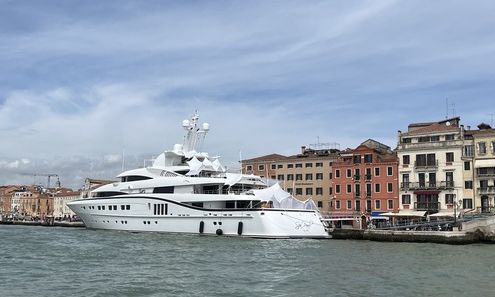The Sea Pearl docked near the entrance of the Venice Biennale © The Art Newspaper
Visitors walking along the water to the 60th Venice Biennale pavilions from St Mark's Square during this week’s preview have undoubtedly noticed the massive yacht docked near the entrance to the Giardini. The ship, called the Sea Pearl, is reportedly owned by Indian-born Indonesian billionaire Sri Prakash Lohia.
Lohia is the billionaire chairman and founder of Indorama Corporation, and made his fortune in petrochemicals and textiles. He has a large collection of lithographs and rare books. His daughter-in-law, Aarti Lohia, leads the SP Lohia Foundation and is a significant collector of contemporary South Asian art. Aarti Lohia is serving as this year’s British Council ambassador for the Venice Biennale, with John Akomfrah’s British pavilion. On 16 April, Aarti Lohia threw a reception onboard the Sea Pearl to support fundraising efforts, the British Council confirmed. The SP Lohia Foundation did not immediately respond to a request for comment.
The ship is more than 82 metres long, according to its maker Abeking & Rasmussen, and photos and videos show multiple decks and an onboard pool. The yacht can reportedly accommodate around a dozen overnight guests in seven cabins and features include a gym and cinema.
During the 2011 edition of the Venice Biennale, mega collector Roman Abramovich docked his 115-metre boat Luna near the Giardini, a move that agitated locals and spurred the then-mayor to threaten a new “oligarch tax” on oversized yachts. For the following edition in 2013, the British pavilion artist Jeremy Deller referenced the incident with a mural of the British social reformer William Morris chucking the superyacht into the Venetian lagoon. The Sea Pearl was joined by another superyacht on 18 April.
This year’s British pavilion by Akomfrah deals with, among other topics, the environment and climate change. A 2021 report by Indiana University researchers found luxury yachts with features like helipads and submarines can burn thousands of tons of CO2 a year, and the team described the ships as “by far the worst asset to own from an environmental standpoint”. Venice, built on more than 100 small islands, is uniquely vulnerable to rising tides and other effects of climate change.

